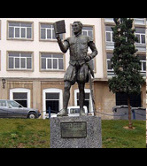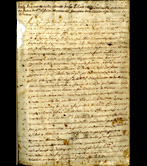Lope García de Salazar: the faction wars
There is a first-hand account of the faction wars, the by the Bienandanzas e Fortunas by the Bizcaian bandit Lope García de Salazar (1399-1476). Everything about his life reflects the world that he lived in. An Oñacino, he challenged Azkoitia. When he returned from exile in Andalusia, internal family tensions and the alliance he made with old enemies in order to protect his position led to him being held captive by one of his sons in his own manor house, Muñatones (Muskiz). After various attempts at escape, he died of poisoning in the Salazar manor house in Portugalete.
The Bienandanzas relate in great detail the author’s many armed confrontations. They can be read as a book of knight errantry, as an enormous genealogical register, as a military manual or as a description of the world of the nobility of that era, laying bare the codes of conduct of the Parientes Mayores (the equivalent of clan chiefs) and their society, in which both internal and external relationships were based on violence.
(http://parnaseo.uv.es/Lemir/Textos/bienandanzas/Menu.htm)
Reading them, it is clear that society was organized territorially, under an uncompromising system of leadership and justice based on family revenge. One interesting example is the Ezpeleta, who burned the Lord of Senpere (both families were involved in the factions that confronted each other at Lapurdi). In the absence of a male heir, his daughter married Pedro López de Amezketa, “the best lancer in Gipuzkoa”, who then had to exact revenge. He confronted Beltze de Ezpeleta and challenged him to a fight to the death to see who was the stronger. In the duel, Amezketa avenged his father-in-law.
García de Salazar witnessses many other events, such as the burning of Mondragón. He also relates how his brother-in-law Gómez González de Butrón and his people were called on by Guaraya to collect what Abendaño and others of the gamboín faction had left behind. Gómez González de Butrón entered Mondragón on June 11, 1448, after heavy fighting. The gamboínos, numerically superior, wanted to fight him on the battlefield, and in order to force him out of the city, they set fire to the villa. This episode left numerous dead on both sides and Mondragón sacked and destroyed.
This is the world we see reflected in the work of the bandit García de Salazar – its key players’ values, codes of conduct and actions – and this is the world that the Province of Gipuzkoa through its villa Association, mostly put behind it.




